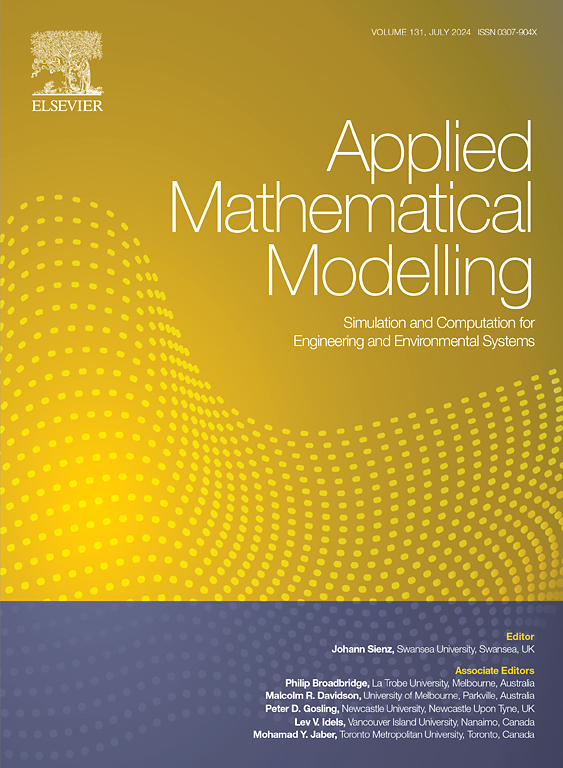Coupled critical plane-pseudo excitation method for multiaxial fatigue analysis of structures under random vibration
IF 4.4
2区 工程技术
Q1 ENGINEERING, MULTIDISCIPLINARY
引用次数: 0
Abstract
This study proposes a coupled critical plane–pseudo excitation method for assessing multiaxial fatigue damage in mechanical structures subjected to random loads. Within the modal coordinate framework, we derive an expression for the spectral moment of the structural stress response using the pseudo excitation method, which facilitates the decoupling of spatial characteristics from frequency domain properties. For the input power spectral density, represented as an integer power function, we employ eigenvalue decomposition and the residue theorem to derive an analytical expression for the spectral moment of the modal displacement response. By constructing equivalent stress modes based on the maximum shear stress and normal stress criteria, we obtain an expression for the equivalent stress variance. Intelligent optimization algorithms are utilized to determine the critical plane position and the corresponding equivalent stress spectral moments, followed by the application of the Dirlik method for fatigue assessment. A numerical example involving random vibration multiaxial fatigue analysis of an L-shaped thin-walled plate demonstrates the effectiveness of the proposed coupled critical plane–pseudo excitation method in comparison to the traditional critical plane method that relies on the stress covariance matrix for calculating equivalent variance. The results confirm the accuracy and efficiency of our approach, and we further explore the impact of different forms of the excitation power spectral density and the damping ratios on the computational outcomes.
用于随机振动下结构多轴疲劳分析的耦合临界面-伪激励法
本研究提出了一种耦合临界面-伪激励方法,用于评估承受随机载荷的机械结构的多轴疲劳损伤。在模态坐标框架内,我们利用伪激励方法推导出结构应力响应频谱矩的表达式,这有助于将空间特性与频域特性解耦。对于以整数幂函数表示的输入功率谱密度,我们利用特征值分解和残差定理推导出模态位移响应谱矩的解析表达式。通过根据最大剪应力和法向应力标准构建等效应力模态,我们得到了等效应力方差表达式。利用智能优化算法确定临界平面位置和相应的等效应力谱矩,然后应用 Dirlik 方法进行疲劳评估。一个涉及 L 形薄壁板随机振动多轴疲劳分析的数值示例表明,与依赖应力协方差矩阵计算等效方差的传统临界面方法相比,所提出的临界面-伪激励耦合方法非常有效。结果证实了我们方法的准确性和高效性,我们还进一步探讨了不同形式的激励功率谱密度和阻尼比对计算结果的影响。
本文章由计算机程序翻译,如有差异,请以英文原文为准。
求助全文
约1分钟内获得全文
求助全文
来源期刊

Applied Mathematical Modelling
数学-工程:综合
CiteScore
9.80
自引率
8.00%
发文量
508
审稿时长
43 days
期刊介绍:
Applied Mathematical Modelling focuses on research related to the mathematical modelling of engineering and environmental processes, manufacturing, and industrial systems. A significant emerging area of research activity involves multiphysics processes, and contributions in this area are particularly encouraged.
This influential publication covers a wide spectrum of subjects including heat transfer, fluid mechanics, CFD, and transport phenomena; solid mechanics and mechanics of metals; electromagnets and MHD; reliability modelling and system optimization; finite volume, finite element, and boundary element procedures; modelling of inventory, industrial, manufacturing and logistics systems for viable decision making; civil engineering systems and structures; mineral and energy resources; relevant software engineering issues associated with CAD and CAE; and materials and metallurgical engineering.
Applied Mathematical Modelling is primarily interested in papers developing increased insights into real-world problems through novel mathematical modelling, novel applications or a combination of these. Papers employing existing numerical techniques must demonstrate sufficient novelty in the solution of practical problems. Papers on fuzzy logic in decision-making or purely financial mathematics are normally not considered. Research on fractional differential equations, bifurcation, and numerical methods needs to include practical examples. Population dynamics must solve realistic scenarios. Papers in the area of logistics and business modelling should demonstrate meaningful managerial insight. Submissions with no real-world application will not be considered.
 求助内容:
求助内容: 应助结果提醒方式:
应助结果提醒方式:


